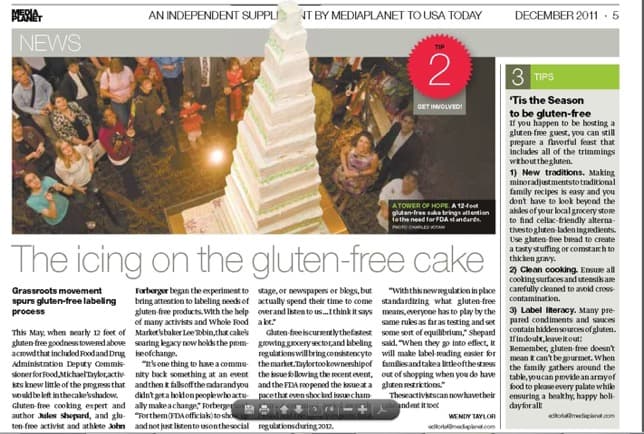In the wake of today’s news that the FDA gluten-free food labeling regulations have (finally) been finalized, there are a lot of questions about what, exactly, this means.
A quick review of how we got here and what this means for consumers reading labels, going forward:
In 2007, the FDA attempted to tackle the task of defining “gluten-free” for the purposes of labeling consumer products. Although they proposed a rule and opened a comment period, no final rule was ever issued.
 In May of 2011, the founders and collaborators of 1in133.org constructed the “World’s Tallest Gluten-Free Cake” and submitted a petition to the FDA with over 10,000 consumer signatures demanding that the FDA finish the task of defining “gluten-free” food labeling regulations.
In May of 2011, the founders and collaborators of 1in133.org constructed the “World’s Tallest Gluten-Free Cake” and submitted a petition to the FDA with over 10,000 consumer signatures demanding that the FDA finish the task of defining “gluten-free” food labeling regulations.

Deputy FDA Commissioner Michael R. Taylor joined Congresswomen Lowey and McCollum at the 1in133 “Gluten-Free Food Labeling Summit” held in Washington, DC, where he assured the group that the FDA would take up the task with renewed vigor, and promised to have draft regulations out within 3 months. (see photos of cake and the event here)

True to his word, on August 2, 2011, the FDA issued draft regulations and reopened a comment period on the January 23, 2007 rules.

Once the comment period closed, FDA considered the new science and safety assessments and issued a final rule, which it submitted to the Office of Management and Budget (OMB) and the White House for approval. The regulations had been awaiting approval until today, when it was announced (two years to the date that the FDA re-opened the comment period in 2011, and the 9th anniversary of the Food Allergen Labeling and Consumer Protection Act – FALCPA) that the final rules had been approved, and would go into effect in exactly 1 year, on August 2, 2014.
The new FDA regulations do many things, but the core principles of the regulations allow manufacturers to voluntarily label a food “gluten-free” if the food does not contain any of the following:
-
an ingredient that is any type of wheat, rye, barley, or crossbreeds of these grains (“prohibited grains”)
-
an ingredient derived from these grains and that has not been processed to remove gluten
-
an ingredient derived from these grains (like wheat starch) that has been processed to remove gluten, if it results in the food containing 20 or more parts per million (ppm) gluten
-
20 ppm or more gluten or 20 micrograms or more gluten per gram of food
The goal of these regulations is to establish a definition for the term “gluten-free” and uniform conditions for its use in the labeling of foods will ensure that persons with celiac disease and gluten sensitivity are not misled and are provided with truthful and accurate information.
The FDA says it is “setting a gluten limit of less than 20 ppm (parts per million) in foods that carry this label. This is the lowest level that can be consistently detected in foods using valid scientific analytical tools. Also, most people with celiac disease can tolerate foods with very small amounts of gluten.
This <20ppm gluten level is consistent with those set by other countries and international bodies that set food safety standards.”
Foods such as bottled spring water, fruits and vegetables, and eggs can also be labeled “gluten-free” if they inherently don’t have any gluten.
This final rule applies to all FDA-regulated foods, including dietary supplements, but does not apply to foods and beverages whose labeling is regulated by the U.S. Department of Agriculture (USDA) and/or the Alcohol and Tobacco Tax and Trade Bureau (TTB). FDA:
“Generally, USDA regulates the labeling of meats, poultry, and certain egg products (FDA regulates the labeling of shell eggs). TTB regulates the labeling of most alcoholic beverages, including all distilled spirits, wines that contain 7 percent or more alcohol by volume, and malted beverages that are made with both malted barley and hops.”
Because the ELISA testing methods currently accepted for testing gluten in foods “do not adequately detect gluten in fermented and hydrolyzed foods” (like ‘gluten-reduced beer‘), FDA reports that it intends to issue a proposed rule on regulating labeling for these products.
The regulation was published on Aug. 1, 2013 in the Federal Register, and gives manufacturers exactly one year to bring their labels into compliance. Taylor “encourage[s] the food industry to come into compliance with the rule as soon as possible.” (read more here)
Under the new rule, a food label that bears the claim “gluten-free,” or “free of gluten,” “without gluten,” and “no gluten,” but fails to meet the requirements of the rule would be deemed misbranded and subject to regulatory action by FDA. (read FDA Q&As here)
 “This is a huge victory for people with celiac disease,” says Andrea Levario, executive director of the American Celiac Disease Alliance (ACDA). “In fact, that’s the understatement of the year.”
“This is a huge victory for people with celiac disease,” says Andrea Levario, executive director of the American Celiac Disease Alliance (ACDA). “In fact, that’s the understatement of the year.”
Congratulations to all of those who supported the 1in133.org endeavor, donated to the cause, spread the news and signed our petition. It truly was a community effort we can all be proud of.
So pat yourself on the back the next time you are shopping and see a gluten-free label — we can now look forward to knowing what that means!
























This is very good news for whole gluten free foods and I am thankful to you to share this news to your users.
I have not found any information on gluten in medications. I believe there was gluten in the pain pills I took after back surgery last fall. I had no gluten in my house, but after 2 days at home, I began having the old familiar symptoms of gluten in my diet. The best Walgreens could do was read the label – starch as the filler. Thankfully we have a compounding pharmacy here and they made up gluten free pills for me. When I asked the pharmacist about the FDA regulations, he said they don’t apply to medications… because of the small dose I would guess?? But after two days there seemed to be a cumulative effect with me… Have you heard of any with the same problem? I’m looking once again for info because Walgreens changed their supplier for one of my daily meds – filler the generic “starch”… Will try communicate with the new company to see if they can give me any info.
Hi Sandra, I was just giving a lecture in Baltimore about this very issue today! The FDA regulations will NOT apply to prescriptions, but they are working on another set of regulations which will. There are many cases of the fillers in prescriptions being made with gluten, so it’s imperative that you ask your pharmacist to confirm with the manufacturer whether the ingredients are gluten-free or not.
Couldn’t be happier to hear this. I wrote a recap on the new FDA gluten ruling as well.
Will this mean that rye, barley and oats need to be labelled now?
Hi Kelly, great question! It will not mean that rye, barley and oats need to be labeled in the same way that “wheat” is labeled on packages now. According to the FALCPA act, only the top 8 food allergens must be called out on a label – this includes wheat, but not the other sources of gluten. What it will mean, is that if a manufacturer wants to put “gluten-free” on their products, they must be ready to prove that their product contains less than 20ppm gluten. It’s a step in the right direction, but it still is wise to check with manufacturers about their products if you have any questions about how they are produced or contamination possibilities.
Thank you for all the hard work on this…Folks who need to be GF can breath (eat) a little easier now…
Thanks, Therese. We will take all the progress we can get, but yes, it was hard fought!!!
Jules-
I want to take a moment to recognize that while I know it takes a team, it especially takes someone with a passion, a spiritual gift, and a bit of legal knowledge doesn’t hurt. My son was diagnosed in 2008, the first year of controlled study in this country and you made cookies with him in Columbus, Ohio. You change lives individually and now nationally. Thank you and don’t stop!!
Gratitude and love,
Susan and Lucas
Charlotte, NC
Oh Susan, it means so much to me to hear from people who I’ve been able to help in some way. I had such fun in Columbus making cookies with those kids – to know that even one of them was touched or benefited from the experience warms my heart and makes all the hard work worthwhile. Thank you so much for taking the time to write to me and please give your son a hug from Miss Jules!!!
Thank you for all your hard work in helping to make this new FDA regulation a reality, Jules.
Do you think it will ever come to pass that gluten will need to be declared on all products sold – just as eggs, nuts, etc. are required to be identified? I think that would make every celiac’s life much easier when shopping.
Hi Cindy, thanks so much for your kind words. It was a ton of work, but truly a community effort we can all be proud of! As for your question about mandatory labeling, I don’t see that in our near future. FALCPA mandated that the top 8 food “allergens” be labeled when present in foods. Gluten is an odd ingredient, in that it is present in wheat, barley and rye, and is not simply a single ingredient in itself. Barley and rye are nowhere near the top most present food allergens, so it would really take a change in the way the law is written to take gluten into account. You’ve heard the expression, “It will take an act of Congress to get that done,” well, that’s what it will take! We will certainly keep the pressure on, but it won’t be anytime soon.
Thank you, Jules, from Tender Foodies everywhere! We appreciate your tireless work and fabulous giant cake building skills :). Inspiring that a community, with good leadership, can make important, fundamental changes!
Thanks, Tender Foodie!
I was so excited to hear this today! Jules, thank you for being such a champion for the entire gluten free community. I am personally grateful for all you have done to push for labeling regulations. I also appreciate the amazing products and recipes you provide for those of us who must eat gluten free. You have made my GF life “better than normal!”
Oh Annella, you have made my day to hear that! Thanks so much for taking the time to write to me! I hope that these labeling regulations will make everyone’s lives at least a little easier, and if my products and recipes make lives tastier, too, then all the better!
This is fantastic news. But it looks like we have to wait one more year for this to come into affect. So we still need to be cautious for the next year with products labeled “gluten-free.” Also, once August 2, 2014 arrives, keep in mind that that’s only for products produced that day and afterward. Earlier products will still have the older labeling. Is it also possible that there will be a lag in producing new gluten-free labels that comply to the new standards for next August? I know sometimes companies don’t update their labels.
Good questions, Rachel, but to be clear, after August of 2014, manufacturers who are using a gluten-free label MUST be doing so in compliance with the rule. That is why there is a one-year lag time between publication and compliance, to give manufacturers time to comply and print new labels.
This is a good start but I see potential problems with this ruling for some people.
“The FDA says it is “setting a gluten limit of less than 20 ppm…This is the lowest level that can be consistently detected in foods using valid scientific analytical tools.”
I have a home test kit, certified accurate, that tests down to 10 PPM and I understand there are more sophisticated tests that can test down to 3 PMM. If under 20 PPM is allowable then the food can contain anywhere from zero to 19 PMM gluten. So you eat a cracker with 19 PMM and you’re OK, then you eat three, are you still OK? And if so, are you really or are you just not having overt symptoms.
“…most people with celiac disease can tolerate foods with very small amounts of gluten.”
What is “most” people? That could be 51%, but what about people who have reactions to trace amounts of gluten. For those, the FDA is setting up a situation that may be worse. Please correct me if I’m wrong but, in the future Manufacturers will probably not be motivated to go through the time and expense of getting certified gluten free since that certification will not mean as much as it does now.
Sandra, you ask some great questions. Pam Cureton, the dietitian for the Center for Celiac Research, has explained it this way:
“Multiple studies have shown that an exposure of 10 mg per day (equal to 1/8th of a tsp of flour) of gluten is a safe level for the majority of people with celiac disease.
“How does this translate into the total amount of food eaten in a day? If a gluten-free food has a contamination level of 20 ppm, a person could include up to one pound (16 oz or 448 grams) of those food products before the consumer reaches the safe level of 10 mg.
A slice of gluten-free bread is approximately 28 grams or 1 ounce. If the bread has a gluten level of 20 ppm, you have to eat 18 slices of bread to reach 10 mg (18 x 28 = 504 grams).
Rice cereal is 27 grams or approximately 1 ounce per cup, therefore you could eat 18.5 servings (27 x 18.5 = 499.5 grams).
Gluten-free pasta is 55 grams or approximately 2 ounces per ½ cup serving, therefore you could eat nine servings before reaching 10 mg of gluten (9 x 55 = 495).”
(http://somvweb.som.umaryland.edu/absolutenm/templates/?a=1617)
To answer your question about manufacturers and paying for gluten-free certifications, I look at it like this: what’s the best way for a manufacturer to protect itself from potential consumer complaints about their products if labeling gluten-free? Invest in independent certification. Also, as you have pointed out, many people react to minute amounts of gluten, and so will choose to purchase only products certified by independent agencies that test and certify to less than 10ppm gluten — a more stringent standard than the FDA has set. I have always had my products certified by GFCO and chosen to have my products manufactured in a facility that is completely free of gluten and the top 8 food allergens. I believe this is the best way to assure the safety of my products for the gluten-free population, of which I am a member. I think taking more precautions and paying for certifications is the right thing to do, and I’m sure other manufacturers will choose to follow suit, in spite of or even because of the new FDA regulations.
Thank you for the explanation about the allowable amounts of gluten. I was confused about the PPM and total milligram levels. That does make me feel better. However, I sincerely hope manufacturers will continue to seek certification for those who do react badly to trace amounts.
I’m happy that helped, Sandra. I agree with you and will continue to encourage other manufacturers to seek certification as well. I still believe it’s the best solution for manufacturers AND consumers!
I’m more excited about this than I was about my birthday last week! Seriously though, what a huge relief to all of us celiacs trying to navigate the minefield of trying to eat gluten-free.
Seriously though, what a huge relief to all of us celiacs trying to navigate the minefield of trying to eat gluten-free.
I do wish that the FDA was requiring gluten-free testing before companies could make the claim, but hopefully the companies will voluntarily do it in order to meet the standards.
Thank you Jules for all of your hard work on this. I wish we lived near each other – I’d bring some cake to celebrate!
That would be wonderful, Michelle! You’re such a talented GF baker – your cake would be a treat! Raincheck?
You bet!
Let them eat cake! All 700-pounds of it.
Thanks for the dedication to the community, Jules!
And you, as well John! Thanks for all you did to make this a reality!
So this means that not all companies who have “gluten free” on the their label have to test their products? What about companies that process ingredients that contain gluten in the same factory? Like companies that mill various flours, sometimes on the same equipment? For example, not all of Bob’s Red Mill Flours are labeled gluten free if they aren’t milled on his “gluten-free” side.
Great question, Margaret. What this means is that IF a company chooses to put GF on their packaging, they are responsible for their products meeting the new FDA standards. If called into question, their products would likely be tested to ensure their compliance, and penalties will issue if they fail. If there are products manufactured in the same facility that contain gluten, they are responsible for making sure that the products labeled GF actually meet the FDA standards. If they are unsure their products will meet that standard every time, they should choose not to use the GF label.
On behalf of the celiac community, THANK YOU Jules!!!
Thanks so much, Gluten Dude. It was truly a group effort! So glad we have a cause for celebration now!!